
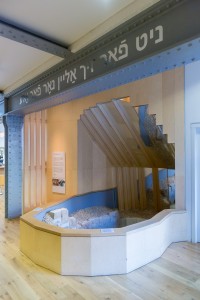
Reigate stone with modern stone infill, London, 13th century, 2009.16
This is a mikveh, a Jewish ritual bath. Dating from the mid-13th century, it is one of the oldest objects in the museum. This mikveh links the long history of Jewish people in Britain to a religious practice still shared by Jews around the world.
The mikveh was discovered on a building site in the City of London in 2001. It was built in the home of the Crespin family, members of the Jewish community that lived in the area during the medieval period. It may have been used for the family in private worship, or in preparation for public worship.
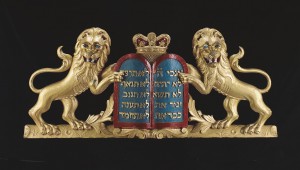
1987.52
Many synagogues displayed a decorative Ten Commandments near the Ark.
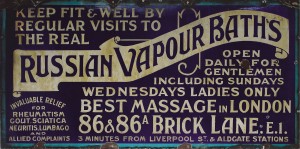
2002.27
The vapour baths were on Brick Lane in Spitalfields and were known as "Schewzik's" after their owner Benjamin Schewzik. They were busiest on Friday evenings when men would go before the Sabbath.
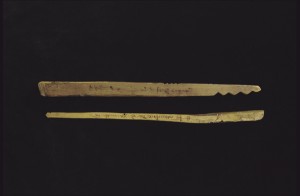
Gloucester, 13th century, JM653 653A
The first stick shows payment of one shilling by Isaac the butcher, probably relating to the 1241 tax of Gloucester Jews. The stick was notched to indicate the payment and then split into two “receipts”. Payment could be check by matching them back together.
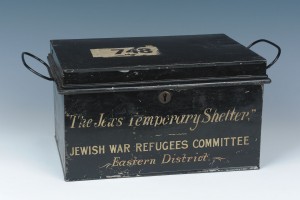
1992.39.38
The Jews' Temporary Shelter provided newly arrived immigrants in London with food and shelter while they looked for a place to live and work.
Residents could put their valuables in this box for safekeeping, or as a safeguard for a small cash loan. The objects found in it give us hints about the lives of the immigrants, but we know very little about their owners or why they were never collection.

2008.99
Leon Greenman and his family were deported to the Nazi concentration camp of Auschwitz-Birkeanu in 1943, despite their British nationality. Leon's wife Else and his son Barney were murdered in the gas chambers, but Leon survived six concentration camps.
Leon wore this uniform at Buchenwald camp, the final camp he was held prisoner, and where he was liberated by American troops on April 11 1945. He later asked a friend to add on his Auschwitz number, 98288.
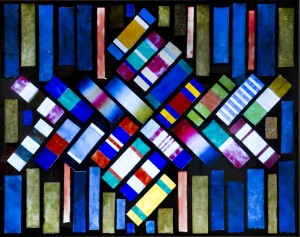
The AJEX Memorial Window is a lasting tribute to the all Jews who have fought for the British Armed Forces. The window was commissioned by AJEX (The Association of Jewish Ex-Servicemen and Women) and designed by the eminent graphic designer Abram Games in 1987.
Each of the coloured strands at the centre of the design represents a medal ribbon from British campaigns in which Jewish people have served. The medal ribbon bars create the shape of a Star of David and are surround by colours that represent the Army, Navy and Air Force.
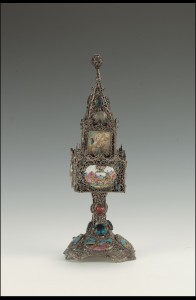
Schwäbisch Gmünd, Germany, mid-18th century, JM414
One of eight spice towers made in this town, famous for its metalwork.
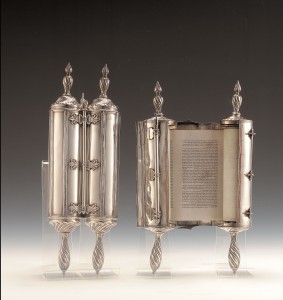
Case and rollers: London, 17866-1767, Frederick Kandler, C1992.21.2
These travelling Torah scrolls were made for Rabbi Falk, the Ba’al Shem of London. Originally from Germany, he was well-known as a follower of the Jewish mystical tradition of kabbalah.

Northern Italy, 17th or 18th century, JM14
This beautiful Ark is believed to come from a Venice synagogue. It was discovered in 19332 in Chillingham Castle, Northumbria in use as a steward’s wardrobe. It may have been purchased in Italy by an English nobleman making the Grand Tour. It was one of the first objects presented to the museum.
The Ark is made of Italian walnut with gilded and marbled paintwork. It is decorated with carved Jewish symbols, including the seven-branched Temple menorah and a handwashing basin on the doors, and Aaron’s rod and the pot of manna on the sides. The Hebrew inscription over the top reads “Know before whom you stand”.
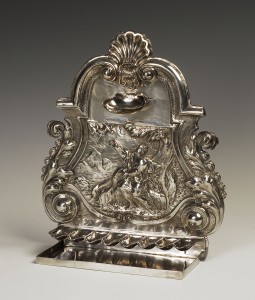
London, 1709, John Ruslen, JM230
The earliest known English Hanukah lamp was made for Elias Lindo on his marriage. The Lindo family were founder members of the early Sephardi community in London. The lamp shows the biblical story of Elijah being fed by ravens, a reference to Lindo’s Hebrew first name.
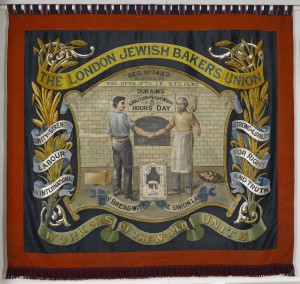
1925, 1984.126
This painted silk banner was made around 1925 and is one of only two surviving Jewish union banners in Britain. It belong to the London Jewish Bakers’ Union, the longest-lived Jewish trade union, which operated from 1905 to 1970. The banner reminded shoppers to buy bread with the union label, which guaranteed that it was baked under acceptable working conditions. The other side of the banner has the same slogans in Yiddish.
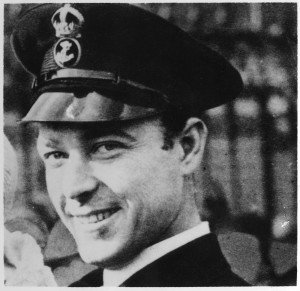
Loaned by the Jewish Military Museum, JMM 2014.119
Tommy Gould was awarded this Victoria Cross for outstanding bravery while serving on the submarine HMS Thrasher during World War II. Gould and his comrade removed an unexploded bomb wedged in the submarine’s outer casing saving the lives of all those on board.
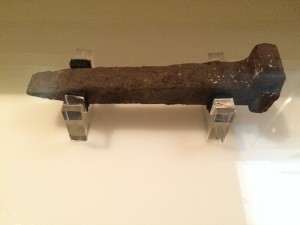
Loaned by the Jewish Military Museum, JMM 2009.141.2
David Arkush served as a Captain in the Army Dental Corps in Singapore and was captured by the Japanese in 1941. He was sent to work in on the Burma-Siam ‘Railway of Death’ on the River Kwai. He and the Dutch Rabbi Nussbaum together established a synagogue in the camp and provided pastoral care for Jewish inmates. This is a railway spike David Arkush brought back from the Burma-Siam railway.
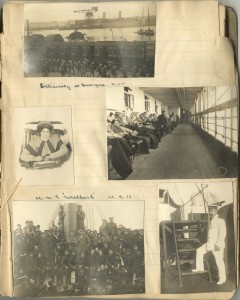
Loaned by the Jewish Military Museum, JMM 2013.44.9
In this diary Oppenheimer descries serving as a nurse on a hospital ships around the Mediterranean including the Gallipoli campaign. Post-war she became the cookery writer, Florence Greenberg.